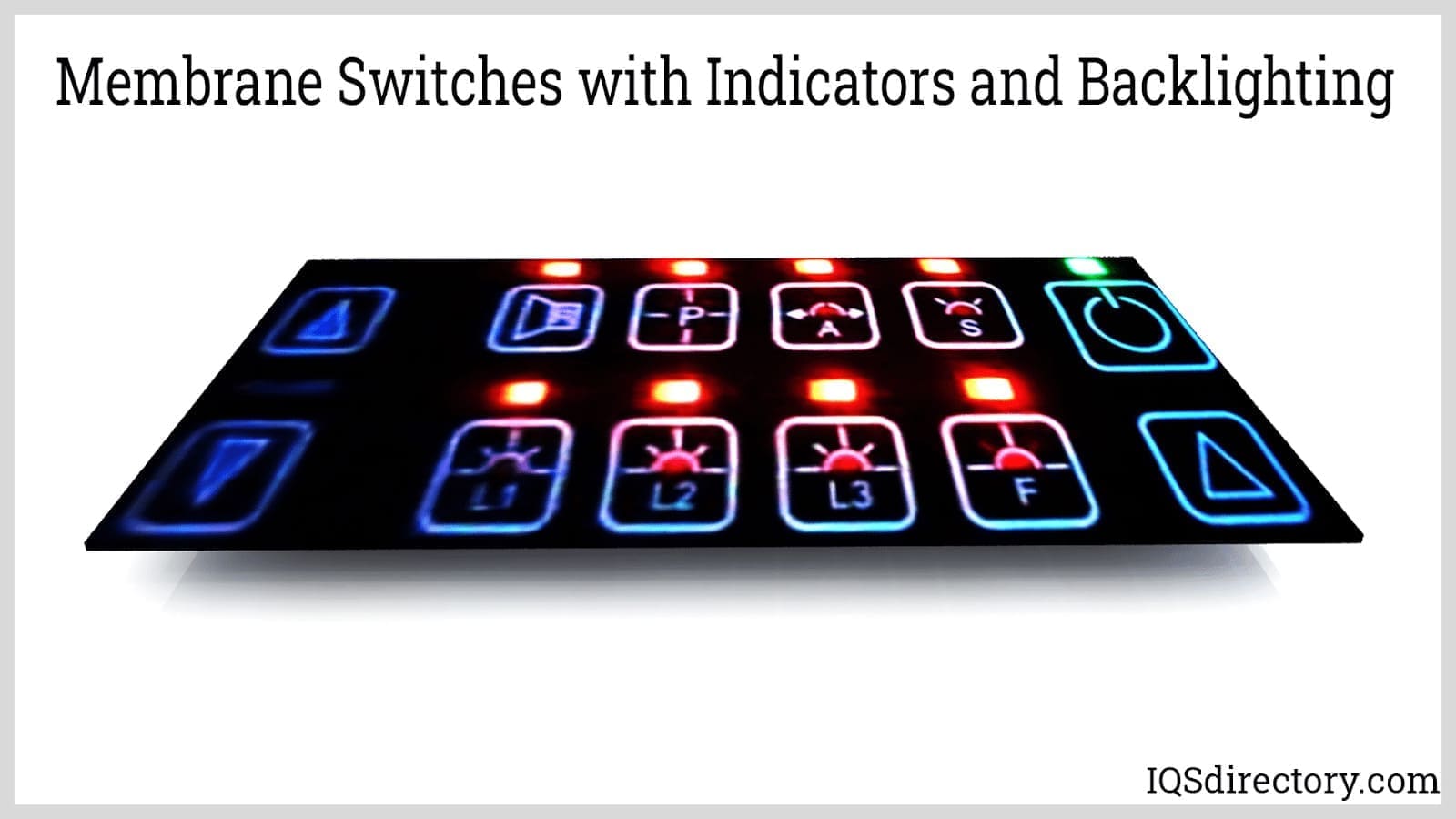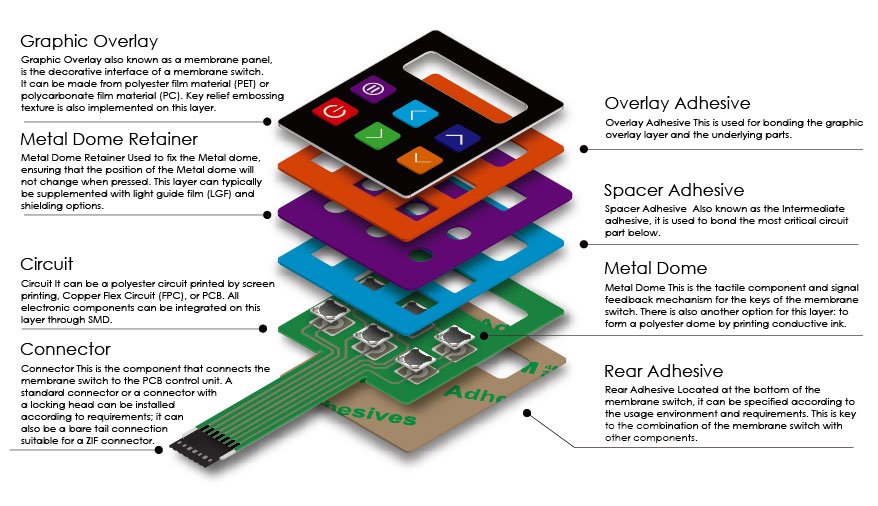The Manufacturing Refine Behind Membrane Layer Switch Over: What You Required to Know
The production process behind membrane changes combines cautious style, product choice, and quality assurance. It begins with comprehending the ins and outs of membrane layer switch style and proceeds via different stages, consisting of product options and printing methods. Each stage plays a necessary role in making sure performance and resilience. The complexities of layer building and the rigorous screening criteria might expose insights that are not instantly obvious. What exists past these foundational elements?
Comprehending Membrane Layer Switch Layout
Membrane buttons might show up easy at very first look, their style entails complex factors to consider that assure capability and durability. The style process begins with a thorough understanding of user requirements, consisting of the user interface's desired application and ecological factors. Comfort designs is a crucial aspect, as the layout has to facilitate simplicity of usage while making sure that tactile feedback fulfills customer expectations.Moreover, the layering of parts, such as visuals overlays, sticky layers, and conductive traces, need to be specifically engineered. membrane switch. This layered arrangement not only influences the switch's responsiveness however likewise impacts its durability. Focus is given to the sealing techniques used to shield versus moisture and dust, which can endanger performance. Furthermore, style factors to consider encompass appearances, where color pattern and aesthetic clearness improve individual experience. Eventually, the layout of membrane layer switches over equilibriums capability, customer experience, and longevity, making certain that they satisfy the demands of various applications efficiently
Materials Made Use Of in Membrane Layer Switch Production
When choosing materials for membrane switch manufacturing, it is vital to ponder both performance and resilience. The main products consist of polyester and polycarbonate films, which offer adaptability and stamina. These films are frequently covered with glue to guarantee appropriate bonding to substratums. Conductive inks, usually made up of silver or carbon, are crucial for producing electrical connections within the button, enabling for trusted operation.Additionally, a safety layer, such as a hard coat, is frequently related to boost scratch resistance and longevity. The selection of backing product, such as acrylic or foam, can substantially influence the switch's tactile feeling and overall customer experience. Numerous ecological aspects, consisting of temperature and humidity, need to assist material selection to ensure peak performance in specific applications. Inevitably, the ideal mix of materials contributes to the membrane switch's performance and lifespan, making educated options vital for suppliers.
The Printing Refine: Creating Graphics and Text
The printing process in membrane switch production plays a significant function in producing high-quality graphics and text. Different graphic layout methods are used to guarantee aesthetic charm and performance, while mindful ink selection approaches are crucial for resilience and performance. Understanding these components is basic for achieving best results in membrane layer button style.
Graphic Layout Techniques
Graphic design methods play an essential role in the printing procedure of membrane layer switches, as they define exactly how graphics and text will eventually show up on the final product. Reliable graphic layout involves the calculated use of fonts, layouts, and colors to enhance readability and aesthetic charm. Designers often use vector graphics for scalability, ensuring that pictures stay sharp at different sizes. In addition, interest to comparison and placement is essential, as it affects user interaction and visual top quality. The incorporation of branding components, such as logos, have to be taken care of with care to maintain brand honesty. Overall, thoughtful graphic style techniques contribute considerably to the capability and attractiveness of membrane layer buttons, influencing customer experience and item efficiency.
Ink Choice Approaches
Selecting the proper ink is essential for accomplishing the preferred aesthetic high quality and longevity in membrane button production. Numerous ink kinds are used, consisting of solvent-based, water-based, and UV-curable inks. Each kind provides distinctive attributes, such as resistance, adaptability, and attachment to ecological variables. Solvent-based inks are usually favored for their resilience and lively shades, while water-based inks are extra eco pleasant yet may have constraints in adhesion. UV-curable inks offer quick treating and durable performance. In addition, color matching techniques ensure that the selected inks straighten with layout specs. Ultimately, the option of ink must think about variables such as application technique, substrate compatibility, and end-use needs to attain remarkable results in membrane layer switch graphics and message.
Layer Building And Construction and Setting Up

Material Selection Process
A careful choice of products is crucial in the production process of membrane layer buttons, as it straight affects functionality and longevity. The primary materials made use of include polyester, polycarbonate, and various conductive inks. Polyester is commonly favored for its excellent resistance to chemicals and abrasion, making it suitable for harsh atmospheres. Polycarbonate, on the other hand, gives exceptional clarity and effect resistance, which is useful for applications needing presence and robustness. Conductive inks, commonly made up of silver or carbon, are crucial for developing reliable electrical paths. In addition, the choice of adhesive products affects the general stability of the button - membrane switch. Evaluating aspects such as environmental exposure, tactile responses, and visual requirements guides manufacturers in choosing the best products for their specific applications
Layer Bond Techniques
Adhering layers in membrane layer switch construction is a crucial procedure that assures performance and durability. Numerous my link adhesion methods are utilized to safeguard perfect bonding in between layers, which typically include the usage of adhesives, warmth, and stress. Pressure-sensitive adhesives (PSAs) are generally made use of for their simplicity of application and instant bonding abilities. Additionally, thermal bonding techniques can be used, where heat is utilized to trigger glue buildings, securing a strong bond. The option of adhesion method mostly depends upon the products entailed and the particular application needs of the membrane button. Correct positioning and uniform application of adhesives are necessary to prevent flaws, securing the button runs effectively throughout its designated life expectancy.
Top Quality Control Steps
Ensuring quality control throughout the layer construction and assembly of membrane switches is crucial for keeping performance and dependability. This process typically entails several critical measures, consisting of thorough assessments at each phase of production. Manufacturers use sophisticated screening techniques, such as peel tests and adhesion assessments, to validate the honesty of layer bonds. Furthermore, visual evaluations are conducted to determine any kind of problems in printing link or product inconsistencies. Environmental problems, such as temperature level and humidity, are carefully checked to guarantee excellent curing and bond. Regular calibration of devices aids keep exact manufacturing criteria. By carrying out these high quality control measures, makers can substantially decrease the threat of item failing, ensuring that the final membrane layer switches meet the required specifications and consumer assumptions.
Testing and Top Quality Control Procedures

Developments in Membrane Switch Over Technology
As developments in modern technology continue to develop, membrane layer buttons are taking advantage of Read Full Article ingenious growths that enhance their performance and customer experience. One noteworthy advancement is the combination of capacitive touch modern technology, which enables for more instinctive and responsive user interfaces. This shift not just improves aesthetic appeals yet likewise reduces mechanical wear and tear, extending the lifespan of the switches.Additionally, improvements in graphic overlay materials have resulted in boosted resilience and resistance to ecological elements such as dampness and UV light. These materials now provide improved clarity and illumination, additional elevating the visual appeal.Furthermore, the incorporation of smart modern technology is transforming membrane layer switches into interactive control panels, enabling connectivity with IoT tools. This connectivity cultivates a smooth user experience, leading the means for applications in various industries, from medical care to consumer electronic devices. Jointly, these technologies placement membrane layer switches as essential parts in contemporary tool layout.
Frequently Asked Inquiries
The length of time Does the Membrane Layer Change Manufacturing Refine Take?
The period of the membrane layer button production process can vary substantially. Aspects such as intricacy, materials made use of, and production volume influence timelines, with typical production ranging from a few days to numerous weeks for conclusion.
What Are the Typical Applications for Membrane Layer Buttons?
Membrane layer switches are frequently made use of in numerous markets, consisting of vehicle controls, household appliances, medical gadgets, and customer electronics (membrane switch). Their convenience and toughness make them suitable for applications calling for user-friendly interfaces and reputable efficiency in diverse atmospheres
Can Membrane Switches Be Customized for Particular Needs?

What Is the Life expectancy of a Regular Membrane Switch?
The lifespan of a normal membrane switch differs, however generally, it varies from 1 to 5 million cycles. Aspects such as use, environment, and material top quality significantly influence longevity and general efficiency over time.

Are Membrane Switches Over Environmentally Friendly?
The environmental friendliness of membrane layer switches over differs. Some products used may not be recyclable, while others can be green. The general impact depends upon making techniques and materials, demanding mindful consideration throughout option and disposal. The manufacturing procedure behind membrane changes combines cautious style, product choice, and high quality control. It starts with comprehending the intricacies of membrane layer switch design and proceeds through different phases, including product selections and printing strategies. When choosing materials for membrane switch production, it is vital to contemplate both efficiency and durability. A mindful option of products is important in the production procedure of membrane switches, as it straight affects functionality and toughness. The choice of bond approach largely depends on the products involved and the certain application needs of the membrane button.